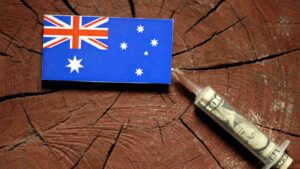Four ways AUD movements directly impact your finances and how Aussies got it so wrong

A lack of knowledge about how exchange rates work could be costing Aussies money. Pic: Getty Images
- AUD movements can have a significant impact on individual and business finances and the economy
- 91% of Aussies don’t even know what an exchange rate is according to a recent survey
- Money Transfer Comparison said findings of survey very concerning as lack of knowledge costs Aussies money
Did that purchase from a US website cost you more money than you thought? How about that overseas holiday – was it cheaper or more expensive than you budgeted?
Have you factored in fluctuations in the exchange rate when making international investments?
A new survey has found a lot of Aussies don’t understand the Australian dollar movements impact them personally or the economy, which could be costing them money. There’s a good reason you should make your kids choose their tech and sports gear from an Aussie website.
Even more concerning 91% don’t know what is an exchange rate according to a survey of an independent panel of 1002 Australians, commissioned by Money Transfer Comparison, helping Australians source the best rate in international money transfers.
Costs of living hitting hip pockets
The increasing costs of living hurt the hip pocket for many Aussies in 2022 with consistent interest rates rises from May as inflation reached 32-year highs. CPI was 7.3% over the year in November, according to the latest ABS figures.
As Deakin University behavioural finance academic and Morningstar analyst Erica Hall told Stockhead recently “the party is over” in 2023 and consumers may be forced to change spending habits amid rising interest rates and higher costs of living.
Movements in the AUD
One way to save costs is being aware of movements in the AUD. The Australian currency fluctuated throughout 2022, peaking in early April to 76 cents against the US dollar, before falling to 62 cents in October, its biggest fall since April 2020.
While it rose to 68 cents against the US dollar in November, by January this year the dollar sits at ~70 cents.
The Australian dollar also remains low against other global currencies and is currently ~57 cents against the British pound and 64 cents against the Euro.
Four ways AUD movements impact finances and what Aussies got wrong
In the Money Transfer Comparison survey, respondents were presented with four statements about the AUD and were asked to identify those they believed were true or false.
How can we put this nicely? A significant proportion were incorrect but keep studying Aussies – we are confident you’ll do better next time.
1. True or false? When the Australian dollar exchange rate increases against the US dollar, goods and services in Australia are cheaper for US tourists. ❌
False. Goods in Australia become more expensive for Americans when our dollar goes up in value against the USD.
Nearly two-thirds (65%) of respondents believed the statement was true. Similar proportions of respondents across different ages and states struggled to determine whether the above statement was true or false.
Over-50s respondents, by a small margin, could correctly identify the above statement as false, at 39%, followed by 36% of 25-54-year-olds and just 26% of under-35s.
Similarly, just over a third (37%) of Queensland respondents could correctly identify the statement as false, followed closely by 36% of Victorians, 35% of NSW respondents and 34% of South Australians and West Australians.
2. True or false? When the Australian dollar drops in value against the US dollar, products that Aussies purchase from the US are cheaper. ❌
False. A lower Australian dollar makes overseas purchases in USD more expensive for Australians, as it is more expensive for Australians to exchange their funds to the US dollar.
In fact, When the Australian dollar is higher against the US, tourists from the US or those living in the US will pay more for goods purchased from or within Australia.
More than half (58%) of survey respondents believed the above statement was true.
3.True or false. The exchange rate is a fee charged by banks on every overseas purchase or overseas money transfer. ❌
False. The exchange rate refers to the difference in value between two currencies, such as the Australian dollar and the US dollar.
For instance, under the current exchange rate of 70 cents against the USD, Australians will be paying more to receive less US dollars in return.
Come on Aussies. Nearly two-thirds (65%) of respondents believed the above statement is true.
However, it is, as Money Transfer Comparison told us, worth noting fees by banks are involved in international purchases and money transfers.
“In addition to the exchange rate, banks will charge an international transaction fee, which is incurred on overseas purchases and international money transfers. This fee averages approximately 3% of the sale price of an item, which can become costly for Australians who regularly make overseas payments,” they said.
4.True or false? When the Australian dollar increases against the US dollar export prices go up for foreign buyers.
True. But a quarter (26%) of respondents believed this statement was false.
Overall, a third (33 %) of respondents incorrectly indicated all four statements were true, despite only the above statement being correct, while 91% got at least one statement wrong.
Survey findings ‘concerning’
Money Transfer Comparison founder and managing director Alon Rajic said it is concerning to see many Aussies lacking fundamental knowledge on the AUD, its movements and its impact on the economy and individual finances.
“Given the low value of the dollar, coupled with inflation, Australians will need to be prepared to spend more on goods purchased within and from the US this year,” he said.
“Keeping an eye on exchange rates, and timing transfers of funds, will be especially important when sending money this year.”
Rajic said the ongoing fluctuations in the AUD are likely to continue well into 2022, with forecasts of only a slight increase to US 72 cents by June.
“However, AUD movements will likely be unpredictable, given the current climate and a projected economic downturn,” he said.
Related Topics
UNLOCK INSIGHTS
Discover the untold stories of emerging ASX stocks.
Daily news and expert analysis, it's free to subscribe.
By proceeding, you confirm you understand that we handle personal information in accordance with our Privacy Policy.








